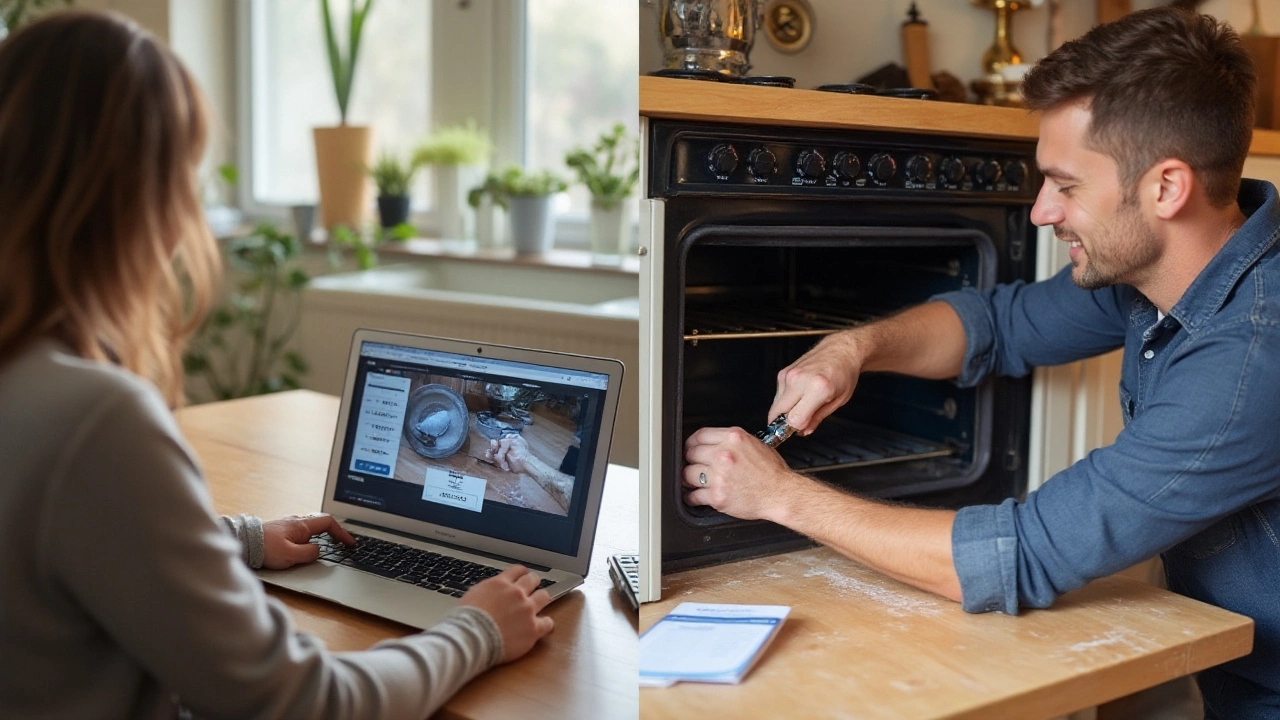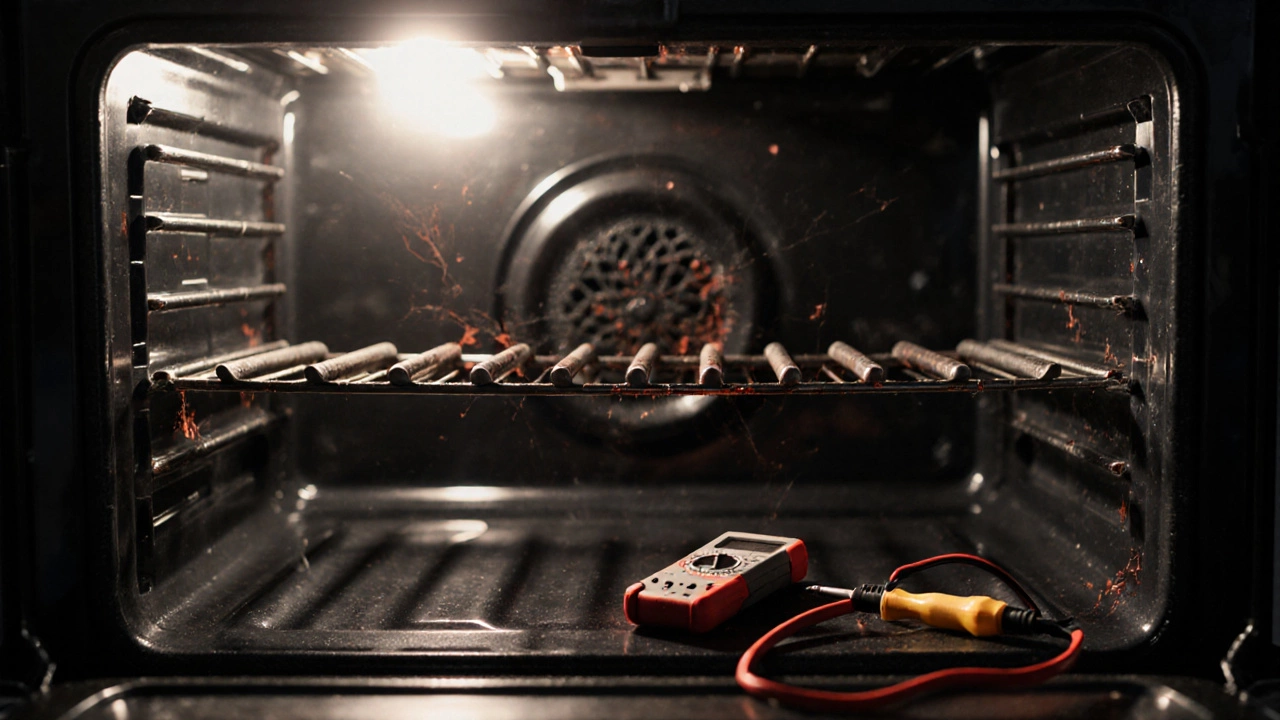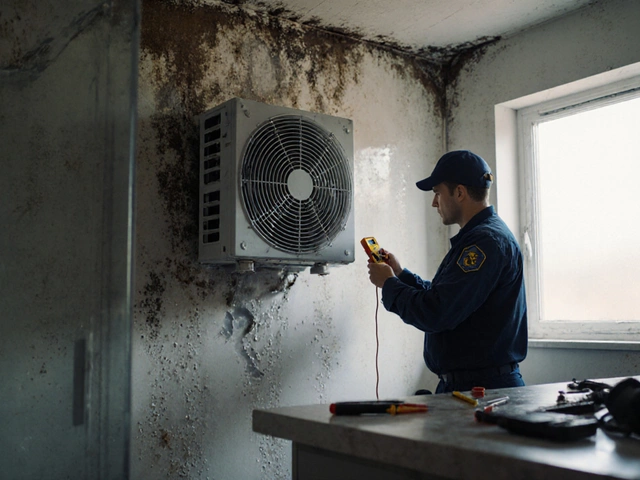Facing a malfunctioning oven can be frustrating, especially when it happens close to the holidays. Many households rely heavily on their ovens, and when the element goes out, it can put a damper on meal plans. Replacing an electric oven element isn't as daunting as it sounds. Understanding the costs and the process can help you make an informed decision.
Whether you're a DIY enthusiast or prefer leaving repairs to professionals, there are options that suit every skill level and budget. We'll delve into how you can identify the signs of a faulty element, the cost implications of replacing it, and ways to ensure your oven continues to serve scrumptious meals, year after year. With a bit of knowledge, you can tackle this common household repair with confidence.
- Identifying a Faulty Oven Element
- Factors Influencing Replacement Costs
- DIY vs. Professional Repair
- Where to Source Replacement Elements
- Cost-Saving Tips
- Ensuring Longevity of Your New Oven Element
Identifying a Faulty Oven Element
Identifying a faulty oven element is the first critical step in ensuring your cooking appliance is back in peak condition. A malfunctioning oven element can manifest in several ways, but a sharp eye can usually pinpoint the signs. The most obvious indicator is when the oven fails to heat properly. If you find your cakes or casseroles consistently undercooked or your broiled dishes lacking the usual golden crust, it might be wise to suspect your oven element. An electric oven relies on its heating element for both off-the-shelf and gourmet cooking efficiency, and any lapse in performance should raise red flags.
A visual inspection can swiftly confirm suspicions of a faulty element. Before proceeding, always ensure safety by turning off the power to the oven at the circuit breaker. After opening the oven door, examine the heating element, which is often found at the bottom or top of the oven cavity, depending on its design. Look for any obvious signs like visible damage, warping, or even cracks and blisters. These are telltale signals that the element has burned out or is on its way there.
Listen for Strange Noises
Another subtle clue of an issue with your oven element is the presence of unusual noises when the oven is in operation. Sometimes, a hissing or popping sound can indicate that the element is arcing or has a break somewhere. Listening carefully to your oven can often clue you into mechanical or electrical issues that are not immediately visible. Electric oven repair becomes necessary long before these minor nuisances turn into full-scale repairs or damage other parts of the oven.For those who doubt their senses, a multimeter can be a valuable diagnostic tool. This device can test whether the element is still conducting electricity as it should. You'll want to carry out a continuity test by placing the multimeter probes on each terminal of the element. A healthy element will exhibit stability in its readings. If it's showing infinite resistance (or an open circuit), then replacing the element is the right call.
"A malfunctioning oven heating element is often behind burnt or undercooked meals," says appliance expert James Broderick. "Understanding how to diagnose your oven's issues is half the battle won in appliance uptime."
These signs, though common, can often be overlooked. It's easy to attribute uneven baking or slightly altered cooking times to mere human error or recipe discrepancies. But acknowledging a problem early can save not just on expensive repairs but also on the energy bill, as a faulty element can cause the oven to draw more power to work harder and longer to reach or maintain desired temperatures. Always remember, addressing the problem swiftly ensures the longevity and reliability of your oven’s performance.
Factors Influencing Replacement Costs
When it comes to replacing an electric oven element, the costs can vary significantly. The first factor that comes into play is undoubtedly the oven element cost itself. Depending on the make and model of your oven, the price of a replacement element can range from as low as $25 to well over $100. Popular brands and newer models tend to have more expensive parts, not only due to brand prestige but because they often incorporate advanced technology for better energy efficiency and cooking precision.
Another crucial factor is whether you decide to undertake the repair yourself or hire a professional. Opting to DIY can save you on labor costs, which might range from $50 to $200 depending on the complexity of the oven and local labor rates. However, it's important to consider the tools required and any potential learning curves. Doing your research or watching a tutorial might seem time-efficient, but without the right tools or experience, you could end up spending more in the long run.
Brand and Model Specific Variations
It's worth noting that different brands and models have their own unique requirements. For example, European brands might require metric tool sets, which could represent additional expenses if you're used to only SAE measurements. Then, there are variations like dual-fuel ranges, which combine gas and electric elements, bringing their own set of intricacies to the repair process.
"Properly understanding the replacement parts and necessary tools for your specific oven model is like having a roadmap on a road trip," notes expert technician Alex Johnson. "Missing a step or using the wrong part can add untold travel time and unexpected detours."
Finally, unexpected costs always seem to pop up during repairs. Always account for the potential need to replace sustainability items like broken panels or damaged fuses that aren’t working as efficiently as they should. Considering these potential unexpected expenses is a smart strategy when budgeting for your repair.
| Cost Component | Estimated Range |
|---|---|
| Oven Element | $25 - $150 |
| Professional Labor | $50 - $200 |
| DIY Tools | $10 - $50 |
Your local market can also affect replacement costs, with higher prices in urban areas compared to rural regions. Demand plays a role, particularly during peak seasons when people are baking more. Run a quick price comparison between different suppliers to find the best deal and reflect on whether there may be additional shipping prices if sourced online.
In summary, being informed about what drives the costs can empower your decisions around whether to handle the repair or call in a specialist. Evaluating these factors will help you ensure that replacing your oven element is a well-considered investment and ultimately, enhancing your oven's lifespan and performance.

DIY vs. Professional Repair
When it comes to replacing an oven element, one of the first considerations is whether to take the do-it-yourself route or call in a professional. Each option has its merits, and the right choice depends on your comfort level with home repairs, the complexity of your oven model, and, of course, your budget. Tackling this repair on your own can be relatively affordable and satisfying, especially if you enjoy hands-on projects. However, it also carries risks, particularly if you're not well-versed in handling electrical components safely.
For many, the allure of a DIY repair lies in its cost-effectiveness. Purchasing a replacement heating element can cost between $20 and $100, depending on your oven's make and model. You may already own some of the tools necessary for the task, such as a multimeter for testing the element and basic screwdrivers for removal and installation. If you decide to go the DIY route, it's crucial to follow the appliance's manual carefully and ensure the power to the oven is completely switched off before starting.
Yet, there's a reason why many people prefer a professional repair service despite the added cost. Hiring a professional can set you back anywhere from $100 to $300, often incorporating both the part and labor. What you're paying for is the peace of mind that comes with expertise. A skilled technician not only has the familiarity with a wide range of models but also the tools to get the job done more efficiently and safely. They can also diagnose the problem accurately—a convenience on its own, as oven issues can sometimes masquerade as heating element failures.
There are instances where enlisting professional help is almost non-negotiable. Ovens with complex electronic controls or high-end models with unique setups may present challenges that exceed the capabilities of most home repair enthusiasts. In these cases, hiring a certified technician ensures that your oven is back in working order without compromising on safety.
"Sometimes it's worth paying for an expert's knowledge," advises appliance repair specialist John Martell, "especially if you're unsure about diagnosing the problem yourself."
If you do choose the DIY option, here are a few tips to ensure success: double-check compatibility when purchasing the replacement element, document the disassembly process with photos, and enlist a friend to help if the oven is too bulky to maneuver alone. Weighing the pros and cons of DIY versus professional repair isn’t always straightforward, but with the right insight and preparation, you can make a choice that is best for you and your circumstances.
Where to Source Replacement Elements
Finding the right parts for your electric oven repair can feel like navigating a maze, but it becomes straightforward once you know where to look. Reliable sources provide peace of mind that you're getting genuine, quality components. The first stop for many is often the oven's manufacturer. They usually sell replacement parts directly and can guarantee compatibility with your appliance model. Before investing, make sure you have the exact model number of your oven, as this detail is crucial for ensuring the replacement element will fit perfectly and function correctly.
Beyond direct purchases from manufacturers, third-party retailers can be lifesavers. Online marketplaces like Amazon or specialized appliance part stores often hold an array of replacement elements for various oven brands and models. These platforms allow you to compare prices, ensuring you get the best deal. Be sure to read reviews and verify product authenticity before making a purchase. In some cases, local appliance repair shops also stock common replacement parts. Visiting in person can be an advantage, as you can get instant advice and verify the product on the spot.
If you're considering revamping more than just one appliance, wholesale suppliers may offer competitive pricing for bulk purchases. This approach is often more economical for landlords or property managers dealing with multiple units. However, when dealing in bulk, confirm the supplier's reputation and the quality of their products, as cheaper doesn’t always mean better. It's worthwhile noting that eco-conscious buyers might want to explore options that minimize environmental impact. Some manufacturers and suppliers offer recycled or refurbished elements that are just as efficient.
"Always ensure you're buying high-quality, compatible components, as using the wrong element can compromise the safety and efficiency of your oven," advises John Matthews, a veteran appliance repair technician.
For those who want to hit the road less traveled, second-hand markets or recycled goods stores might have what you need at a fraction of the price. While this DIY approach could save you some dollars, it's crucial to thoroughly inspect these parts for wear and tear and ensure they're safe to use in your home. Acquiring elements from previously disassembled appliances can often be part of that treasure hunt. Although this option involves some risk, the savings can be worth it if you are knowledgeable about what to look for.

Cost-Saving Tips
When faced with the need to replace an electric oven element, it's natural to start thinking about your budget. Finding cost-effective solutions doesn't mean cutting corners; rather, it's about making informed choices. For starters, one of the simplest ways to save money is by opting for a DIY oven repair approach. If you're willing to roll up your sleeves and have a knack for following instructions, repairing your oven element can significantly reduce expenses. However, ensure that you have the right tools and safety gear before beginning the task. Reading tutorials or watching video guides online can provide valuable insights and tips.
Purchasing the most affordable replacement part isn't always the best strategy. Quality matters, and buying a substandard element may lead to frequent replacements and, ultimately, higher costs. Consider purchasing from reputable manufacturers known for their durable oven elements. To sweeten the deal, look out for limited-time promotions or discounts on websites of major appliance stores. Visiting local hardware stores can also sometimes yield unexpected discounts, particularly during holiday sales.
Consumer Reports once highlighted that "investing in quality parts can save consumers money in the long run,” a testament to choosing wisely when it comes to home appliance repairs.
Another effective way to save money is to compare prices across multiple platforms. The internet offers a treasure trove of options, from where to buy your parts to how much you are willing to spend. Websites often have fluctuating prices, meaning the part you are eyeing today might be cheaper tomorrow or next week. Setting up price alerts via online shopping platforms can help you nab the best deals when prices drop, allowing you to maximize your budget without compromising on quality.
Some might find it beneficial to consult their oven’s warranty or service agreement. Many manufacturers offer extended warranties that might cover part replacements, saving you the out-of-pocket cost altogether. Keep in mind, however, that not all issues covered under warranties are free, as some might only cover labor or parts with specific stipulations. Make sure to read the fine print to avoid any surprises.
Exploring Professional Services
If you decide that self-repair isn't for you, carefully choosing a professional service can still save you money. This often means going for local repair services rather than big-brand operators who might charge a premium. Personal recommendations from friends or family can lead you to skilled technicians who offer competitive rates. Before hiring, request a detailed quote from several businesses. A well-detailed quote allows you to understand all the costs involved and warns you against unexpected expenses.
| Store | Average Element Cost (USD) |
|---|---|
| Local Hardware Store | 35 |
| Online Retailers | 30-50 |
| Major Appliance Stores | 45 |
Lastly, regular maintenance of your electric oven can prevent unnecessary expenses. Simple practices, such as regularly checking and cleaning your oven's interior and ensuring that the seals are intact, can extend the lifespan of your oven's elements. By being vigilant, not only do you prolong the life of your appliance, but you also save money by avoiding frequent replacements.
Ensuring Longevity of Your New Oven Element
Getting the most out of your new oven element is not just about a working replacement; it's about extending its lifespan, ensuring safety, and optimizing performance. Start by inspecting the installation thoroughly to make sure the element is securely fitted and free of defects. Regular checks can prolong the life of an oven element. It's recommended to inspect it at least every six months. A visual inspection can identify any signs of wear or potential issues before they become major problems, helping keep the oven element cost at bay.
Maintaining a clean oven is critical. Residue from spills and food debris can bake onto the element, leading to diminished performance. Use a soft cloth with baking soda and water for a gentle clean that helps avoid corrosive cleaners that may damage the element over time. The choice of cookware can also impact the longevity of your oven element. Consider using flat-bottomed pans, as these ensure even heat distribution. Uneven surfaces can cause hot spots, leading to unnecessary strain on the element. Interestingly, the consistency of power supply affects element durability. Surge protectors can act as guardians against potential electrical spikes, which could compromise the element's efficiency.
Temperature management is another strategy that should not be overlooked. Allowing the oven to preheat fully before placing food inside distributes heat evenly without overworking the element. Additionally, avoid opening the oven door frequently during cooking, as it leads to temperature fluctuations that can impact the element's performance negatively over time. A simple oven thermometer can verify your oven's accuracy, preventing unnecessary strain due to incorrect temperature settings. Investing in precise temperature management tools ensures your oven element doesn't face extra pressure, keeping it functional for years.
"Proper maintenance and smart practices can significantly extend the lifespan of kitchen appliances," suggested by Amanda Green, a home appliance expert. Keeping this in mind could save you both money and hassle in the long run.
For those inclined towards experimentation, energy-saving tips can double as preservation techniques. Consider the residual heat method: turning the oven off a few minutes before the food is ready to capitalize on the remaining heat. This practice not only saves electricity but also modestly reduces the workload on your oven element. On occasions when the oven isn't needed, try alternatives like slow cookers or stovetops, redistributing wear across appliances. It's a small yet impactful habit to cultivate for ensuring longer appliance life.
| Tip | Benefit |
|---|---|
| Regular inspection | Prevents major issues |
| Keep it clean | Maintains performance |
| Use surge protectors | Guards against electrical spikes |
| Energy saving habits | Reduces workload on element |
Finally, you should read the manual that comes with your specific oven model. These guides often provide useful tips and advice tailored directly to optimizing the use of the particular appliance you own. Consider it an investment in the long-term functionality of your oven. Following these practical steps can indeed add years to the life of your oven element, turning simple maintenance into significant savings over time.





